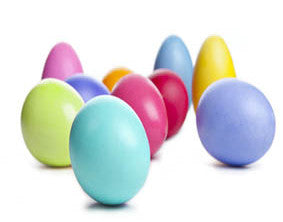Dyed Pastel Easter Eggs
 Spring is here and soon the Easter egg hunt will begin. Even if you don't have kids, decorated eggs can be a cute addition to spring tablescape.
Spring is here and soon the Easter egg hunt will begin. Even if you don't have kids, decorated eggs can be a cute addition to spring tablescape.
Use up your extra dye by making cute egg designs. Tintex can dye Easter eggs for decoration. This is an easy & fun craft that you can do with the kids in no tme. *not suitable for eating.
A small amount of any dye colour will make a pastel (example: use 1/16, 1/8 or 1/4 tsp of dye colour mixed with 1 cup hot water). Start with the smallest amount and add more dye or hot water as needed.
Materials:
- Eggs that have been blown out (optional)
- Faux or decorative eggs made of a dyeable material like paper, nylon or Styrofoam (found in craft stores)
- Tintex dye of your choice
- Wax paper or protective cover for eggs to dry
- Plate
- Spoon(s)
- Dyeing containers (large enough to hold 3 cups (750ml) of water
- Optional: paintbrush or sponge brush
- Optional: painters tape or scotch tape
- Optional: Elastic bands or string
Directions:
- Protect workstation with plastic to prevent staining; wear rubber or plastic gloves to protect skin.
- Prepare dye solution. Thoroughly dissolve Tintex powder with 2 cups (500ml) of hot water.
- Prepare egg with tape, stickers, elastic bands that will be removed after dyeing for a negative-space effect (that will allow the base egg colour show through).
- Place egg on a tablespoon and dip it into the prepared dye bath (either fully submerge or partially dip).
- Keep the egg submerged for approximately 30 seconds or longer for darker or more vibrant results.
- Remove egg, place gently on a plate with raised rims covered with wax paper or plastic.
- Clean work area up as usual to avoid stains.
- Allow egg to dry for 1 hour; remove stickers, tape or elastic bands when dye is completely dry.
- Place gently into an Easter themed basket, bowels or glass vases for display; eggs dyed with Tintex are not suitable for eating.
Colour Splash Blog Related Posts
-
Dyed Paper Garland Tree Decoration
We DIY-ed a standard white paper garland from a craft sto...
-
Holiday Crafts and Decorations
How would you like to add a pop of bold red to holiday gi...



